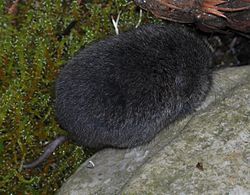| Townsend's vole | |
|---|---|
 | |
| Scientific classification | |
| Kingdom: | Animalia |
| Phylum: | Chordata |
| Class: | Mammalia |
| Order: | Rodentia |
| Family: | Cricetidae |
| Subfamily: | Arvicolinae |
| Genus: | Microtus |
| Subgenus: | Pitymys |
| Species: | M. townsendii |
| Binomial name | |
| Microtus townsendii | |
 | |
| Synonyms [3] | |
| |
Townsend's vole (Microtus townsendii) is a species of rodent in the family Cricetidae, the sister species of M. canicaudus . [3] It is found in temperate grasslands of British Columbia in Canada and in the states of Washington and Oregon in the United States. [1] [4]
Contents
- Description
- Distribution and habitat
- Biology
- Status
- References
- Sources
- Further reading
- External links
Greek root words for "small ear" are the source for the genus name Microtus. [4] American naturalist and writer John Kirk Townsend collected the type specimen in 1835, which accounts for the second part of the name. [5] [6]
